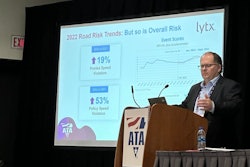If you ask a fleet owner what their top priority is, the most common answer is safety. But a recent survey of more than 1,000 fleets across industries including trucking and logistics, construction, oil and gas, agriculture and delivery shows that while it is a top priority, it’s not the top priority.
According to Motive’s 2023 State of Safety Report, improving safety ranks third behind increasing revenue and minimizing expenses. The report says 95% of those surveyed said driver safety performance is a priority, but 40% said their fleets are underinvested in driver safety initiatives and technology (8% drastically underinvested).
Abhishek Gupta, head of product for fleet management at Motive, said that’s what stood out to him in the survey: that improving safety was not the No. 1 priority.
“I think everyone realizes the cost savings and the fact that (safety) can be a profit center for their fleet, but they're not able to drive that as the highest priority – they're not able to put their dollars as much towards it,” Gupta said.
That’s understandable when considering the challenges fleets face today. The top three, according to the survey, are fuel costs, increased insurance premiums and the driver shortage. But Gupta contends that investing in technology to improve safety can defeat those challenges while helping fleets secure their top priorities of increasing revenue and minimizing expenses.
Safety isn’t a cost center but a cost saver and revenue driver, he said.
Research shows that running a modern, best-in-class safety program addresses those challenges. By identifying and coaching drivers who speed, hard accelerate or hard brake, fleets can correct driving behaviors that negatively affect fuel economy. Reducing accidents and safety incidents can lower insurance costs. And recognizing and rewarding top-performing drivers and those who are improving can help with driver retention and recruitment.










